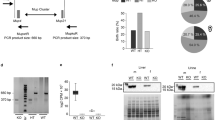Abstract
By labeling liver protein in vivo with [3H]leucine, the relative biosynthetic rate has been measured for the major urinary proteins (MUPs), three closely related, androgen-regulated proteins that are synthesized in mouse liver, secreted into the bloodstream, and excreted into the urine. In livers from females of strain C57BL/6J, total MUP synthesis represents about 0.6–0.9% of the total protein synthesis; in males and testosterone-treated females of the same strain, synthesis increases to about 3.5–4.0% of the total. This 4-to 6-fold induction of total MUP synthesis is similar to the androgen-mediated increase in MUP-specific messenger RNA reported by others, and indicates that the previously observed 20- to 25-fold induction of total MUP excretion into urine is generated partly at the posttranslational level. By measuring the ratio of synthesis of the individual MUPs, it was determined that the testosterone-mediated change in the relative levels of the MUPs in urine reflects a similar change in the pattern of MUP synthesis, indicating that the posttranslational processes operate on the quantity, and not the nature, of MUPs excreted. A survey of seven inbred mouse strains revealed polymorphism for the rate of total MUP synthesis in untreated females. Two classes could be distinguished on the basis of a 3- to 5-fold difference in the rate. This variation does not correlate with variation at Mup-a, a locus that controls the ratio of the three MUPs in urine from androgen-induced mice. These findings are consistent with the notion that MUP expression is controlled by a variety of independently assorting genes.
Similar content being viewed by others
References
Berger, F. G., Paigen, K., and Meisler, M. H. (1978). Regulation of the rate of β-galactosidase synthesis by the Bgs and Bgt loci in the mouse. J. Biol. Chem. 2535280.
Brandt, E. J., Elliott, R. W., and Swank, R. T. (1975). Defective lysosomal enzyme secretion in kidneys of Chediak-Higashi (beige) mice. J. Cell Biol. 67774.
Finlayson, J. S., Potter, M., and Runner, C. R. (1963). Electrophoretic variation and sex dimorphism of the major urinary protein complex in inbred mice: a new genetic marker. J. Natl. Can. Inst. 3191.
Finlayson, J. S., Asofsky, R., Potter, M., and Runner, C. C. (1965). Major urinary protein complex of normal mice: Origin. Science 149981.
Finlayson, J. S., Potter, M., Shinnick, C. S., and Smithies, O. (1974). Components of the major urinary protein complex of inbred mice: Determination of NH2-terminal sequences and comparison with homologous components from wild mice. Biochem. Genet. 11325.
Hastie, N. D., Held, W. A., and Toole, J. J. (1979). Multiple genes coding for the androgen-regulated major urinary proteins of the mouse. Cell 17449.
Hudson, D. M., Finlayson, J. S., and Potter, M. (1967). Linkage of one component of the major urinary protein complex of mice to the brown coat color locus. Genet. Res. Camb. 10195.
Osawa, S., and Tomino, S. (1977). Regulation by androgen of mRNA level for the major urinary protein complex in mouse liver. Biochem. Biophys. Res. Commun. 77628.
Schreiber, G., Rotermund, H.-M., Maeno, H., Weigand, K., and Lesch, R. (1969). The proportion of the incorporation of leucine into albumin to that into total protein in rat liver and Hepatoma Morris 5123 TC. Eur. J. Biochem. 10355.
Sippel, A. E., Kurtz, D. T., Morris, H. P., and Feigelson, P. (1976). Comparison of in vivo translation rates and messenger RNA levels of α2a-globulin in rat liver and Morris Hepatoma 5123D. Can Res. 363588.
Swank, R. T., Paigen, K., Davey, R., Chapman, V., Labarca, C., Watson, G., Ganschow, R., Brandt, E. J., and Novak, E. (1978). Genetic regulation of mammalian glucuronidase. In Recent Progress in Hormone Research, Vol. 34 Academic Press, New York, p. 401.
Szoka, P. R., and Paigen, K. (1978). Regulation of mouse major urinary protein production by the Mup-a gene. Genetics 90597.
Szoka, P. R., and Paigen, K. (1979). Genetic regulation of MUP protein production in recombinant inbred mice. Genetics 93173.
Szoka, P. R., Gallagher, J. F., and Held, W. A. (1980). In vitro synthesis and characterization of precursors to the mouse major urinary proteins. J. Biol. Chem. 2551367.
Author information
Authors and Affiliations
Additional information
This work was supported in part by a grant from the United States Public Health Service (GM 19521).
Rights and permissions
About this article
Cite this article
Berger, F.G., Szoka, P. Biosynthesis of the major urinary proteins in mouse liver: A biochemical genetic study. Biochem Genet 19, 1261–1273 (1981). https://doi.org/10.1007/BF00484578
Received:
Revised:
Issue Date:
DOI: https://doi.org/10.1007/BF00484578




